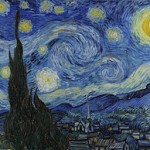Google Art Project expands, with 32,000 works of art now online -
http://www.eschoolnews.com/2012/04/04/google-art-project-expands-with-32000-works-of-art-now-online/

Van Gogh's 'The Starry Night' is one of 32,000 works of art that now can be viewed online in great detail, thanks to Google.
Imagine pulling up a stool next to the lonely diners of Edward Hopper’s “Nighthawks” or dipping your fingers in the basin of “The Child’s Bath” by Mary Cassatt.
These familiar images, along with the sunbathers of George Seurat’s “A Sunday on La Grande Jatte” and the somber figures of Grant Wood’s “American Gothic,” are among the 32,000 works of art that Google released in digital format April 3.
The technology giant partnered with 151 institutions worldwide on the Google Art Project, an online platform for virtually viewing artwork and museum galleries. The company selected the Art Institute of Chicago as the initiative’s North American launch site and hosted museum directors from across the country at a private April 3 event.
Participating institutions, from the White House to the Museo del Oro (Gold Museum) in Bogota, Colombia, selected works from their vast collections to contribute to the Google Art Project. Of this group, 46 museums had their galleries photographed using Google Street View technology, which compiles a 360-degree panorama to create a virtual-tour experience in a high-definition format called gigapixel. Some of the works in Google’s online collection are also rendered in gigapixels.
“The gigapixel imagery of ‘La Grande Jatte’ was truly mind-boggling,” said Sam Quigley, vice president for collections management, imaging, and information technology at the Art Institute. “They took something like 702 images, little pieces of the painting, by photographic technique and stitched together a big mosaic so you’ll be able to zoom incredibly close and see the individual points of paint that the artist used to create that work. It’s really quite something. That’s a technology leadership role that really only a few corporations like Google could provide.”
Many art museums already have digital images on their websites. The Art Institute has about 52,000, Quigley said. But Google is providing superior technology and the heft of a well-known brand whose broad mission is to “organize the world’s information” and make it accessible. The Mountain View, Calif.-based company has applied this mandate to everything from books to recipes to government data.
“The diversity of the institutions is key,” said Piotr Adamczyk, head of data for the Google Art Project. “It’s about finding partners that are eager to put their content online.”
The art initiative grew out of a group of Google employees’ “20 percent time,” a company policy that encourages workers to tinker on personal pursuits one day a week. The project was launched in February 2011 with 1,000 works from 17 museums. It enables users to save their favorites in personal collections and share them with friends via social media tools such as Google+ and Facebook.
Adamczyk, a graduate of the University of Illinois at Urbana-Champaign, previously served as the Metropolitan Museum of Art’s liaison to Google for the first round. He had been the New York institution’s resident “data nerd,” helping curators mount special exhibitions such as last year’s Alexander McQueen retrospective.
Adamczyk and Quigley said they expect the online visibility of museums’ art collections to encourage, rather than cannibalize, offline visitor traffic.

No comments:
Post a Comment